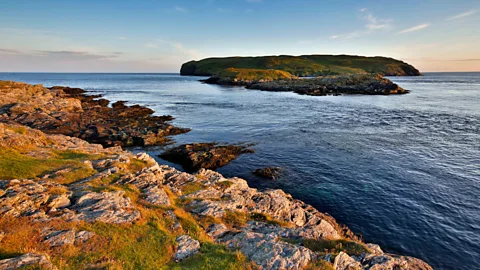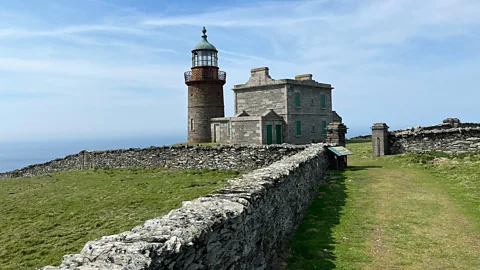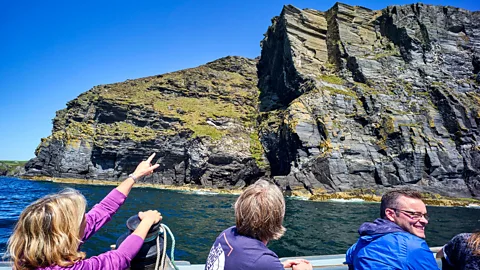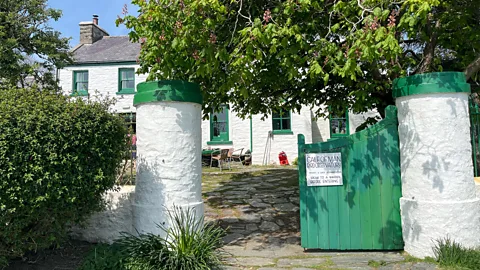Calf of Man: A tiny, wild isle adrift in the Irish Sea
 Alamy
AlamyInhabited over the centuries by hermits, monks, farmers and lighthouse keepers, the remote Calf of Man is both a time capsule and frontier of seabird regeneration efforts.
Down at the harbour, it was time to go sailing. Port Saint Mary, near the Isle of Man's south-west tip, was half-empty; the only discernible morning activity on the jetty the seagulls perched on empty lobster pots with eyes fixed on the boats at anchor. Only one of these was showing any sign of movement, and with its engine ticking over and the stink of diesel in the air, the two-man crew onboard set their little motorboat on course across the open sea. Their destination? One of Britain's most isolated islands, hemmed in by precipitous cliffs and tempestuous waters.
Found less than half a mile off the south-west coast of the Meayll Peninsula of the Isle of Man, the Calf of Man is that rarest of destinations in the British Isles: a thrilling place, but one that's often impossible to get to, no matter the season or how hard you try.
Chiefly, it is a place lorded over by migratory birdlife, including the sooty black and white Manx shearwater, one of the longest-lived UK bird species. This historic island of two ruined lighthouses is also almost uninhabited, except for the two wildlife wardens and two intermittent volunteers who steward the bird observatory from March to November. Outside those months, the island lies empty.
But the racing tidal currents of the Irish Sea and the swirling Calf Sound, which separates it from the British Crown Dependency, frequently make it a treacherous crossing. At times, in gales and rollercoaster tides, the island can be cut off for weeks, and just below the surface, the seabed is littered with shipwrecks. Among them are a 160-tonne brig from Liverpool, a cargo vessel from Glasgow and a French schooner – which means getting to the Calf of Man has all the hallmarks of a pilgrimage.
 Mike MacEacheran
Mike MacEacheranAt the boat's helm that morning was Steve Clague, a Manx sailor who has seen more than his fair share of bad weather. Like his father before him, who'd made the same boat trips to the Calf of Man for 40 years, he believes the island sets people dreaming because it often can be so hard to get to.
"Last July we didn't set sail once," Clague told me, one of the 10 passengers on that day's 4.5-hour sightseeing round trip. Around us, the sea gleamed silver-blue in the morning sun, and scanning left and right, there was no sign of the dramatic cliff-hemmed seascape that would soon take over. "The Calf is a unique, beautiful place. Unspoilt and always transforming. The trick isn't to come once but to see it in all its different moods. It's a little time capsule."
Plan your trip:
Small sightseeing boat trips from the Isle of Man to the Calf of Man operate daily from May to September, weather and tides permitting. Two options are available, with 4.5-hour excursions from either Port Saint Mary or Port Erin on opposite sides of the Meayll Peninsula. Once there, the island is a haven for birdwatchers, and the lighthouses, historic ruins and bird observatory can be visited on walking trails. Boat trips must be booked in advance.
Also on board was Shaun Murphy of Manx National Heritage, which acts as custodian to the Isle of Man's treasure trove of museums and field sites as well as the Celtic crosses that have become symbols of the island. Murphy has been coming to the Calf of Man since his first visit as a schoolchild in 1970, and over the last few years, has visited every month. What motivates his return?
"It's a rare good news story," he replied, watching gannets dive gracefully into the deep. "The guillemot communities are thriving and starting to spread out into the south coast of the island. The Manx shearwater, once preyed upon by invasive rats, has bounced back to around 1,500 pairs. A record number of seal pups were born last year. Efforts are being made to encourage puffins to nest. It's a lot to take in." Commitment and hard work underpin much of this, and as part of the puffin project, 100 resin decoys have been installed along the clifftops to encourage the species' long-term return.
 Alamy
AlamyAs we talked, our boat crossed the sound amid a frenzy of birdlife. Above us, fulmars caught the breeze, but I was equally focussed on the auks, razorbills and kittiwakes nesting on the intricately banded cliffs that thrust skywards. Soon after, two seals glided by, and, slowly, we chugged into the island's rudimentary quay, South Harbour.
More than 1,000 years before we landed on the 616-acre island, Christian monks and hermits are said to have lived here, building an early Christian keeill, or Manx chapel. Fugitives are believed to have taken refuge on the island during Elizabethan times, and in the centuries since, tenant sheep farmers, lighthouse keepers and a series of owners have attempted to tame the island's wild side. One of these was Francis Jeffrey Dickens, son of English novelist Charles Dickens, who eventually gifted the island to the National Trust in 1939 to be preserved as a nature reserve. Ownership was then transferred to Manx National Heritage.
More like this:
• The British islands that disappear every day
• The British island that’s not in the UK
• The secret British language that was used to outwit the Nazis
The result is a jumble of histories: a ramshackle farm track leads past two early-19th Century chess piece lighthouses, where choughs nest in the broken-down towers. A smithy, silo and mill from an earlier era stand derelict, haunted by the ghosts of farmers. Old-style drystone walls, maintained by island volunteers, do little to contain the flocks of four-horned Manx Loaghtan rams and ewes that still graze there.
But most people visiting the Calf of Man come for its sole farmhouse — the Bird Observatory – a half-hour walk from the quayside in a dell at the island's centre where insights into the unique wildlife are readily shared. When I arrived, the wardens were in the midst of painlessly ringing birds with ID bracelets as part of an ongoing census. Like the fishermen who battle the raging seas around them, their days are defined by which breeds slip into their nets each morning. By the time of my visit, nearly 50 species had already been tagged.
 Mike MacEacheran
Mike MacEacheran"If it's a good birding day, we'll be up at first light, ringing different species until lunchtime, then doing counts in the afternoon," said ornithological warden Eleanor Grover, one of two full-time caretakers at the observatory. "It's a quick process, and today we've had a few firsts for the season: an osprey, a lesser whitethroat and a reed warbler."
The work is hard. But the story is yet another positive one. Since the project began in 1959, more than 307,000 birds had been tagged up to the end of last year. And the data created helps monitor migratory routes, lifespan, changes in population and breeding success.
Though the wardens are by nature birding advocates, the days are not without entanglements. "Goldfinches are really nice," Grover said, "but blue tits attack you. They're brave considering their size." For estate warden Kate Fox, the island gives her the rare opportunity to see the revival of the once-endangered Manx shearwater firsthand. Nowadays, the UK is home to around 90-95% of the species, and, as Fox puts it, the brown-tinged seabirds are clumsy and far from comfortable on land: "They're easy to catch, but there's a major drawback. To evade predation, they only come onshore at night."
At that point of my visit, Fox looked at her watch, then at the nearby harbour, where my return boat was waiting, with engine idling. Out loud, I wondered: what happens when the boat is cancelled. She stared out to sea. Then with a small smile added: "There's a wonderful sense of isolation. It's magical."
Looking back, I wondered if the appeal of this speck of land between sea and sky stemmed from something more profound. Maybe it was a metaphor for escape, almost into fiction. A parallel world to run away from, one too busy to care about mythical seabirds and wildly horned sheep, storybook lighthouses and fake puffins. A place of magic, right enough.
--
If you liked this story, sign up for The Essential List newsletter – a handpicked selection of features, videos and can't-miss news, delivered to your inbox twice a week.
